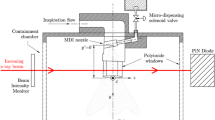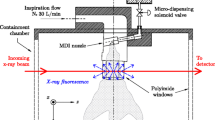Abstract
Purpose
The first pressurised metered dose inhaler (pMDI) was introduced in 1956. Even with excellent inhaler technique typically only 20% of the dose deposits in the lungs where needed. It is hoped that a better understanding of the initial plume formation and expansion during dose release can help improve modelling, devices and ultimately transport to the lungs. We have used two high-speed imaging techniques to investigate the transient dose event.
Methods
Synchrotron phase-contrast X-Ray imaging is a technique that is sensitive to variations in the refractive index of materials in the X-ray region. Similarly, Schlieren imaging is an optical technique sensitive to the refractive index gradients which are often present in pMDI plumes due to gas density variations. We have combined and synchronised both techniques to investigate three commercial pMDIs actuators during dose release for various actuator/formulation combinations.
Results
We have observed temporal phases of propellant flowing in the orifice channel. At early times flash boiling takes place and drives gas emission, steep plume density gradients and liquid jets/droplets at the orifice. Evaporating liquid is present in the sump long after the dose is finished. Regional counter-flow is seen in plumes emitted into a mouth-throat geometry.
Conclusions
As the foamy liquid-vapour mixture is forced out of the sump and into the orifice the liquid walls of the bubbles break into fragments which are forced out of the sump and tend to form a liquid-gas flow in the orifice channel. The period of high density plume observed by the schlieren technique corresponds to flash-boiling-driven liquid exiting the orifice channel.













Similar content being viewed by others
Abbreviations
- API:
-
Active pharmaceutical ingredient
- APSD:
-
Aerosol particle size distribution
- CFD:
-
Computational fluid dynamics
- DPI:
-
Dry powder inhaler
- k:
-
Gladstone-Dale coefficient
- n:
-
Refractive index
- pMDI:
-
Pressurised metered dose inhaler
- ρ:
-
Gas density
References
Usmani OS. Small-airway disease in asthma: pharmacological considerations. Curr Opin Pulm Med. January 2015;21(1):55–67.
Capstick TGD, Clifton IJ. Inhaler technique and training in people with chronic obstructive pulmonary disease and asthma. Expert Review of Respiratory Medicine. February 2012;6(1):91–103.
Dunbar CA, Watkins AP, Miller JF. Theoretical investigation of the spray from a pressurized metered-dose inhaler. Atomization and Sprays. 1997;7:417–36.
Oliveira RF, Ferreira AC, Teixeira SF, Teixeira JC, Marques HC. PMDI spray plume analysis: a CFD study. Lecture Notes in Engineering and Computer Science. 2013:3.
Gavtash B, Versteeg HK, Hargrave G, Myatt B, Lewis D, Church T, et al. Multi-physics theoretical approach to predict pMDI spray characteristics. J Aerosol Med Pulm Drug Deliv. 2017;30(4):A1–A99.
Worth Longest P, Tian G, Walenga RL, Hindle M. Comparing MDI and DPI aerosol deposition using in vitro experiments and a new stochastic individual path (SIP) model of the conducting airways. Pharm Res. 2012;29:1670–88.
Gavtash B, Versteeg HK, Hargrave G, Myatt B, Lewis D, Church T, et al. Transient aerodynamic atomization model to predict aerosol droplet size of pressurized metered dose inhalers (pMDI). Aerosol Sci Technol. 2017;51(8):998–1008.
Berry J, Heimbecher S, Hart JL, Sequeira J. Influence of the metering chamber volume and actuator design on the aerodynamic particle size of a metered dose inhaler. Drug Dev Ind Pharm. January 2003;29(8):865–76.
Versteeg HK, Hargrave GK, Kirby M. Internal flow and near-orifice spray Visualisations of a model pharmaceutical pressurised metered dose inhaler. J Phys Conf Ser. July 2006;45(1):207–13.
Newman SP. Principles of metered-dose inhaler design. Respir Care. 2005;50(9):1177–90.
Settles GS. Schlieren and shadowgraph techniques: visualizing phenomena in transparent media. Berlin. New York: Springer; 2001.
Mason-Smith N, Duke DJ, Kastengren AL, Traini D, Young PM, Chen Y, et al. Revelaing pMDI spray initial conditions: flashing, atomisation and the effect of ethanol. Pharm Res. 2017;34:718–29.
McKiernan AP. Novel techniques for characterising inhalers. J Aerosol Med Pulm Drug Deliv. 2017;30(4):A1–A30.
Xi J, Worth Longest P. Transport and deposition of micro-aerosols in realistic and simplified models of the oral airway. Ann Biomed Eng. 2007;39:572–91.
Reinke P, Yadigaroglu G. Explosive vaporisation of superheated liquids by boiling fronts. Int J Multiphase Flow. September 2001;27(9):1487–516.
Shaik AQ, Versteeg HK. ‘Model for the prediction of internal flow conditions in pressurised metered dose inhalers (pMDIs)’, drug delivery to the lungs 19, December 10-12, Edinburgh. UK. .
Hochrainer D, Holz H, Kreher C, Scaffidi L, Spallek M, Wachtel H. Comparison of the aerosol velocity and spray duration of Respimat soft mist inhaler and pressurised metered dose inhalers. Journal of Aerosol Medicine. 2005;18(3):273–82.
Dunbar CA, Watkins AP, Miller JF. An experimental investigation of the spray issued from a pMDI using laser diagnostic techniques. Journal of Aerosol Medicine. 1997;10(4):351–68.
Acknowledgments and Disclosures
We acknowledge the European Synchrotron Radiation Facility for provision of synchrotron radiation facilities and we thank Alexander Rack, Margie Olbinado and colleagues for assistance in using beam line ID19. We also acknowledge the engineering and tool-making staff of Prior PLM Medical for the design and manufacture of the Schlieren setup and experimental fixture.
Author information
Authors and Affiliations
Corresponding author
Additional information
Publisher’s Note
Springer Nature remains neutral with regard to jurisdictional claims in published maps and institutional affiliations.
Rights and permissions
About this article
Cite this article
McKiernan, A.P. Inhaler Spray Investigation Using High-Speed Phase-Contrast X-Ray and Schlieren Imaging. Pharm Res 36, 120 (2019). https://doi.org/10.1007/s11095-019-2657-9
Received:
Accepted:
Published:
DOI: https://doi.org/10.1007/s11095-019-2657-9




